Know the Etymology: 359
Place Name of the Day: Wednesday, 02 July 2014
Madu-maana, Nara-maana
மடு3மான, நரமான
Maḍumāna, NaramānaMadu+maana
Nara+maana
The area of Madu palms (Cycas circinalis)
The area where the road became impassable; or the bushy part
| Maana |
Also Maanaya: Measure in general including space, length and capacity, way, means (Sinhala, Clough); also, area, direction, part, Prades'aya, Dis'aawa, Pætta (Sinhala, Sorata Thera); Maana: measure (Sanskrit, Rig Vedic, Pali, CDIAL 10041); House, dwelling (Sanskrit, Rig Vedic, CDIAL 10042); Manai: House, dwelling, house-site, a land measure, wife, family, household, domestic life (Tamil, DED 4776, with cognates in 7 Dravidian languages, from the root Mannu, meaning to be permanent, DED 4778, cognates in 12 Dravidian languages)
|
| Madu (Sinhala) 1 |
The false sago palm, Cycas circinalis (Sinhala); Ma'ndeecalu, Mu'ndicalu: The false sago palm, Cycas circinalis (Kannada, Tulu); Ma'nda+eecalu: Eecalu is a cognate of Eegnchu and Eenthu in Tamil meaning wild date palm (DED 2617); Mu'ndi: a kind of edible yam (Kannada, Tulu, DED 4946). The false sago-palm seeds produce flour for food.
|
| Madu (Sinhala) 2 |
(plural and combinations), Maduwa (singular): A shed, hall, temporary building, bungalow (Sinhala); Ma'ndapaya: Temporary building, open shed or hall adorned with flowers and erected on festival occasions, tabernacle, an open building or temple consecrated to a deity (Sinhala); Ma'ndapa: Open temporary shed, pavilion (Sanskrit, CDIAL 9740, CDIAL notes non-Indo Aryan origin for the word); Maadam: Storied house, house, mansion, hall, hut (Tamil, DED 4796 a); Maada: Shrine of a demon (Tulu, DED 4796 a); Meadai: Platform, raised floor, terraced house (Tamil, DED 4796 b). See column on Bodhi-ma'luwa
|
| Madu (Tamil) |
The Tamil place name component Madu and its Sinhalicised form Maduwa, meaning a pond or tank, and are found used in the North, East, North Central and North West parts of the island, belong to a different etymology (DED 4658). See columns on Kevu'liyaamadu,
|
| Nara |
probably changed form of Nera: Road rendered impassable by the jungle or by trees cut down and thrown across (Sinhala); also, jungle, thicket, bush, bushy place, Vanaya, Akulen (Sinhala, Sorata); Nivaara: Keeping off, impediment (Sanskrit, CDIAL 7417); prevention (Pali, CDIAL 7417); Neradu: To be rough, hard, be halting (Tamil, DED 3750); Neradu, Nerudu; That which is rough as a road, rugged (Tamil, DED 3750); Neradu: Uneven (Telugu, DED 3750); Neri: Roughness (Tamil, DED 3750); Naradu: Roughness (Kannada, Tulu (DED 3750); Nerukku: To set thick (Tamil, DED 3770); Neri: To be crowded together (Tamil, DED 3770)
|
| Maanaa |
A cultivated variety of citronella grass (Sinhala); Maanam-pul: A grass name found in Eezham Tamil place names
|
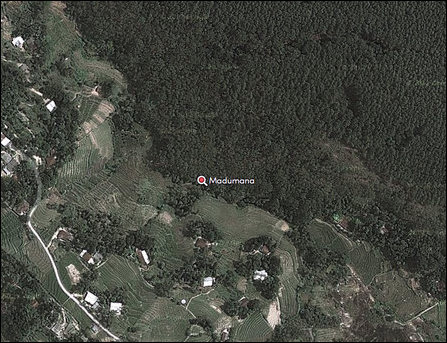
The location of Madu-maana. Note the expanse of jungle found with palms [image courtesy: Google Earth]
The word Maana is used in several shades of meanings in Sinhala. But in the context of place names, it mostly means an area or part of land. In some other instances, Maana as a shortened form of Maanaa, means a kind of grass. Maana usually comes as a suffix when it means an area and comes as a prefix when it means grass.
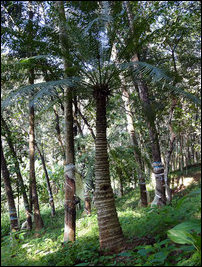
Cycas circinalis photographed in Kerala [image courtesy: Wikipedia]
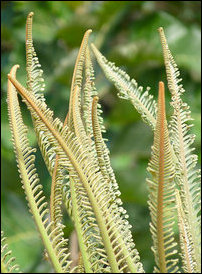
The young shoots of Cycas circinalis [image courtesy: Wikipedia]
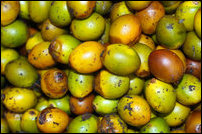
Cycas circinalis seeds. They are removed of husk and processed before making the flour edible.
The land-related meanings for the word Maana, such as area/ region, direction and part (Prades'aya, Dis'aawa, Pætta) could be seen in Sorata's Sinhala dictionary, Sri Sumangala S'abdakoshaya.
Maana, as a spatial estimation of a land in Sinhala, is probably derived from the meaning ‘measure in general' for the same word, in Sanskrit, Pali and Sinhala (CDIAL 10041).
* * *Madu is the name of the false sago palm (Cycas circinalis) in Sinhala. Cognates could be seen in the Kannada and Tulu words Ma'ndeecalu or Mu'ndeecalu for the same palm (Eecalu is a suffix meaning the family of date palms). The palm is also called Goddeecalu in Kannada, meaning the hill date palm.
Cycas circinalis is endemic to the Western Ghats of South India and to the mountainous parts of the island of Lanka/ Ilankai.
Even though commonly called a palm, Madu or Cycas circinalis, is a cycad of the Cycadeceae family that comes unchanged from the Jurassic times.
Some tribes of Kerala, Karnataka and Tamil Nadu make flour for food by processing the seeds of this cycad.
The seeds coming from the female cycad are soaked in water, smoked, dried and roasted to remove toxins, before using the flour for food.
Various items such as Pittu, Idiyappam, Idli, Puzhukku and porridges are made from Cycas circinalis flour by tribes in the Western Ghats of Kerala. The young leaf shoots of the cycad are also used for food.
The food value of Madu seed flour is also noted in the Sinhala dictionaries.
The Madu cycad is also of high medicinal value, as the flower cone of the male cycad is used in making aphrodisiacs and medicinal products made from the pith of the tree are given to lactating mothers. Due to felling for commercialised medicinal use the cycad has become an endangered species today.
* * *Madu/ Maduwa meaning a shed, hall, pavilion, temporary building, bungalow etc., in Sinhala corresponds to another Sinhala word Ma'ndapaya, meaning almost the same and to the Sanskrit word Ma'ndapa (CDIAL 9740), meaning an open temporary shed or pavilion. CDIAL notes non Indo Aryan origins for the word. Maadam in Tamil and related cognates in other Dravidian languages, listed by DED 4796, may be taken for comparison in this context. Also note the usage Madam in Eezham Tamil for open halls on the roadside. See column on Bodhi Ma'luwa, Changku-maal, Aa'rukaal-madam.
Usually the cycad-related Madu comes as a prefix and the shed-related Madu/ Maduwa comes as a suffix in the Sinhala place names.
The word Madu noticed in the Tamil toponyms of the North and East of the island, and its Sinhalicised form Maduwa found in the toponyms of the North Central and North Western parts of the island, invariably mean a pond or tank, usually a deep one. In these contexts, Madu/ Maduwa is related to words listed under Dravidian Etymolgical Dictionary 4658. See column on Kevu'lyaamadu
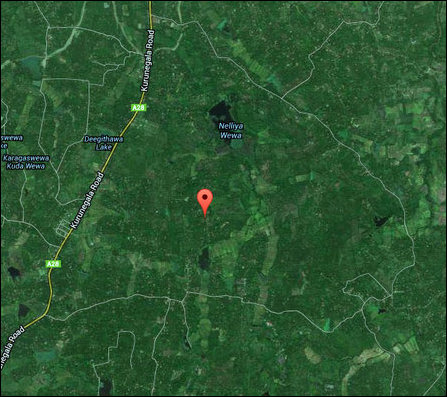
The location of Nara-maana. Note the absence of proper road through the area [image courtesy: Google Earth]
The prefix Nara in the place name Nara-maana is probably a changed form of Nera, meaning a road rendered impassable by jungle. Other meanings for Nera are jungle, thicket, bush or bushy place (Vanaya, Akulan; Sorata's dictionary).
Sanskrit and Pali have a cognate Nivaara, meaning an impediment or prevention (CDIAL 7417). In Dravidian, while, Neradu in Tamil means rough as a road (DED 3750), Nerukku means to set thick and Neri means to be crowded together (DED 3770).
* * *Madu-maana is in Hanguranketha division of Nuwara Eliya district. There is another Madu-maana in Walapane division of Nuwara Eliya district
Nara-maana is a place in
Wariyapola division of Kurunegala district.
* * *Some related place names: Maana meaning an area or a part of land:Maana-kada: The entrance to the area or region; Seethawaka division, Colombo district.
Mee-mana: The part or area of Mee trees; Horana division, Kalutara district
Weli-maanaana: The sandy part; Mathugama division, Kalutara district
Hak-mana: from Hakma'na: The place or terrace for walking; Medadumbara division, Kandy district. Hakma'na = Sakma'na (Sinhala)
Werella-maana: The area or part of Werella trees; Udunuwara division, Kandy district. Wærælla: (singular), Wæra'li (plural): A kind of medicinal plant (Sinhala); Viraali: Jamaica switch sorrel, Dodonea viscosa (Tamil)
Kekiliyaa-maana: probably, Kækilla-maana: The thicket part; or the part of Kækilla fern; Kothmale division, Nuwara Eliya district. Kækilla: small thicket, also a fern, Gleichania linearis. Kækilla-pitiya: Pannala division, Kurunegala district
Kawatayaa-maana: Probably Kaawataya-maana: The area or side of crows; Hanguranketha division, Nuwara Eliya district. Kaavatta: a kind of grass (Malayalam); Kaavattai in Tamil
Meepili-maana: from Mee-pi'li-maana: The road lined by Mee trees; Nuwara Eliya division, Nuwara Eliya district
Naavi-maana: The part of Achyranthes aspera plants; or the area of Gloriosa superba roots; or the sailor's area; Matale Four Gravets division, Matara district. Naavi: Karalsæba plant; Vachchanaavi root (Sinhala, Sorata); the poisonous root, Niyangala (Sinhala, Clough); Nævi: sailor, commander of a ship (Sinhala)
Koa-maana: The small part, or the area of cuckoos; Padiyathalawa division, Ampaa'rai district. Koa = Kudaa (small, short); Koa = Kohaa (Indian cuckoo).
Gavaram-maana: The area of a kind of buffaloes; or the area of mud; Welimada division, Badulla district. Gavara, Gavaraa: A species of buffalo (Sinhala); Gavara-va'la: mud hole, place for the lodgement of dirt or rubbish (Sinhala); Gavala: wild buffalo (Sanskrit, CDIAL 4096); Gaava: ox (Pali, CDIAL 4096); Kavar: anything that forks, from which the male deer is called Kavari (Tamil, DED 1325), Kavalai: a road that bifurcates (Tamil, DED 1325); Kavaram: anything that forks (Malayalam, DED 1325).
Dumbara-maanaana: The Dumbara part (the part of Dumbara village); Ayagama division, Ratnapura dictrict. This is a hamlet from where the road leads to the main village called Dumbara
* * *Maanaa/ Maana meaning grass:Sinhala:Maanaa-boda: The Maanaa-grass field; Ukuwela division, Matale district
Manan-watta: The cultivated grass garden; Pallepola division, Matale district
Maanaa-paaya: probably, the Maanaa grass expanse; Ibbgamuwa division, Kurunegala district
Maanam-pita: The high plain of Maanaa grass; or the high plain serving as path: Niyagama division, Galle district
Maana-vila: The grassy pond, marsh or natural lake; Akmeemana division, Galle district
Maanajjaawa: The grassy jungle (perhaps associated with forest fire); Hambantota division, Hambantota district. Another comparable place name is
Pahajjaawa, in Tangalle division of Hambantota district. Jaawa seems to be the changed form of Daava (J/ D interchange), meaning a forest in Sinhala (Sorata Thera); Daava: forest, also forest always associated with fire (Sanskrit, Pali, Prakrit, CDIAL 6311)
Maa’na-kola: The (locality of) Maanaa grass; Hanguranketha division, Nuwara Eliya district
Tamil:Maanam-pullu: The (place of) Maanam grass; Oddusuddaan division, Mullaiththeevu district
* * *Madu meaning the Madu palm:[The Tamil place name component Madu and its Sinhalicised form Maduwa found in the NC and NW provinces, meaning a pond, is of a different etymology]
Madu-gas-thalaawa: The grassland of Madu palms; Passara division, Badulla district
Madu-van-wela: The paddy field in the forest of Madu palms; Embilipitiya division, Ratnapura district
Madu-van-wela Pæra'nigama: The old village of the paddy fields in the Madu palms forest; Kolonna division, Ratnapura district. Pæra'ni: old, ancient, former, antique, decayed (Sinhala); from Para'na (Sinhala), Puraa'na: ancient (Sanskrit, Pali, Prakrit, CDIAL 8283)
Madu-galla: The rocky hill of Madu Palms: Udadumbara division, Kandy district
Madu-wala: The forest of Madu palms; Mulatiyana division, Matara district
Madu-gama: The village of Madu palms; Siyambalanduwa division, Moneragala district
Madu-kotan- araawa: Probably, the new and detached cultivation field prepared after cutting Madu palms; Badalkumbura division, Moneragala district
Madu meaning a shed or hall: Gal-maduwa: The stone shed or hall; Kundasale division, Kandy district; Damana division, Ampaa'rai district. In the latter instance, the place name could also mean the rock-pond, as Maduwa related to Madu in Tamil, means a pond.
Gam-maduwa: The village hall; Ambanganga Korale division, Matale district
Pahala-gigum-maduwa: Probably, the back part of the sinkhole or pond formed by thunderbolt; or the back part of the hall destroyed by thunderbolt; Neluwa division, Galle district. Gigum: Thunder (Sinhala)
Gam-madu-watta: The garden or grove of the village pond; Hikkaduwa division, Galle district
Agul-maduwa: The locked up hall; Beliatta division, Hambantota district. Agula (singular), Agul (plural): bolt, bar (Sinhala); Agga'laa: cross bolt, bar of a door, bolt (Pali, CDIAL, 628); Aagu'laa: small iron keeper, bolt ring (Oriya, CDIAL 628)
Dehi-maduwa: The shed in the locality of lime shrubs; or the shed to store lime fruits; Mawanella division, Kegalle district
Mal-maduwa: The flower shed; Warakapola division, Kegalle district
Kadawath-maduwa: The shed at the entrance post or border post: Welikanda division, Polonnaruwa district
First published: Wednesday, 02 July 2014, 18:30
Previous columns:











